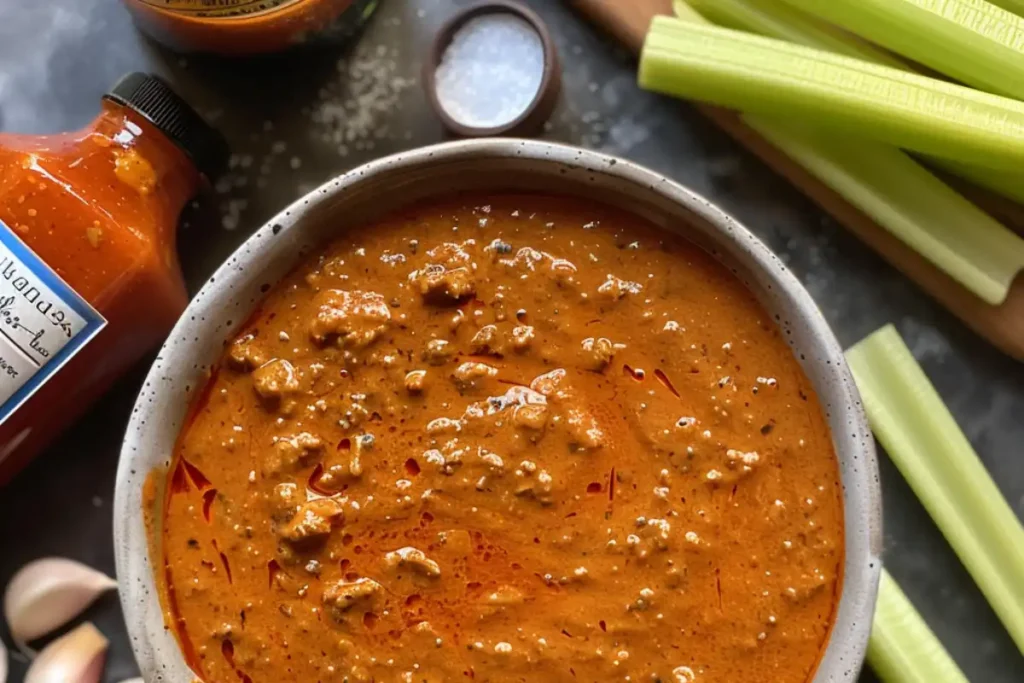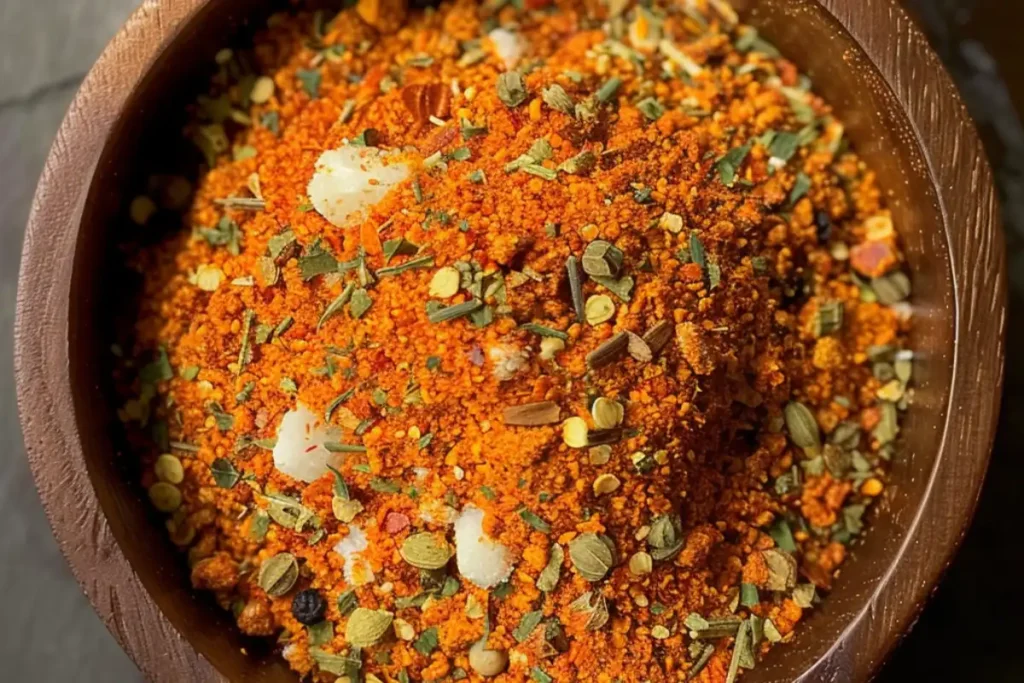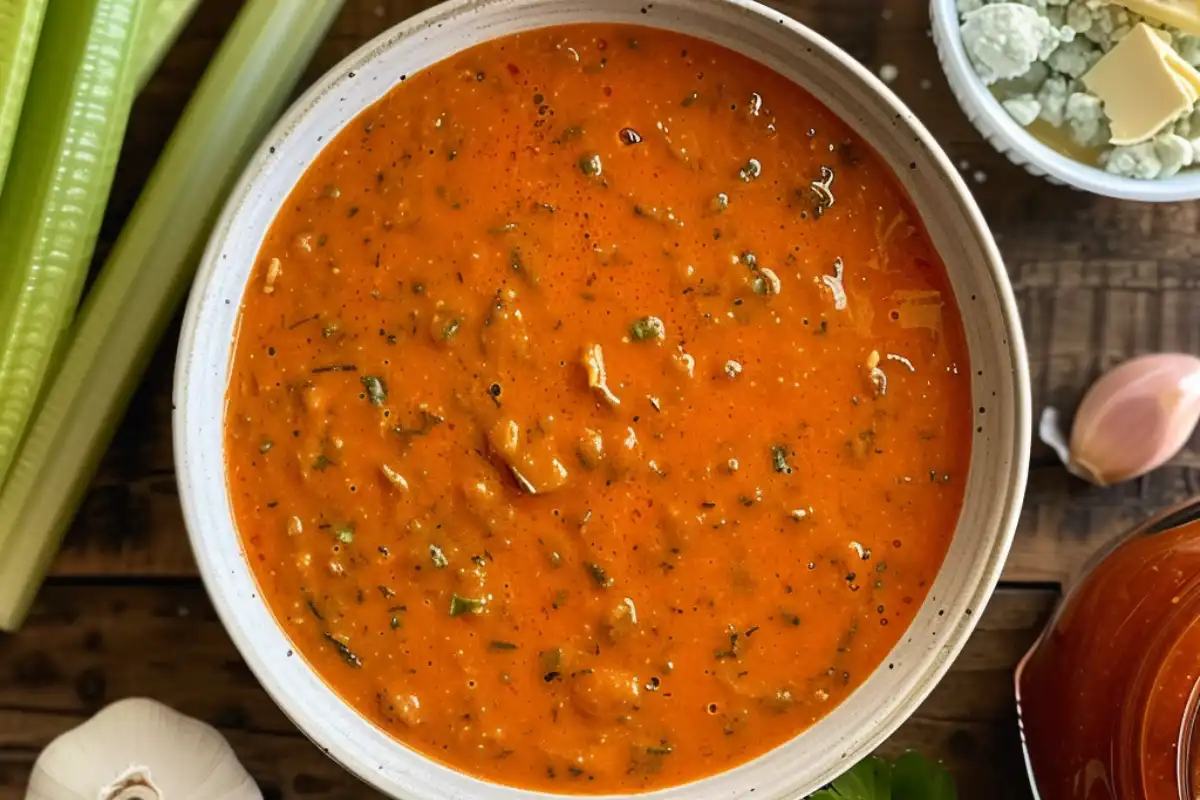The Buffalo flavor is instantly recognizable—spicy, tangy, and buttery, it’s a flavor that has become synonymous with Buffalo wings, a dish that’s deeply entrenched in American food culture. From restaurants to home kitchens, and from game-day gatherings to backyard barbecues, Buffalo wings and the flavor that defines them have transcended their humble origins to become an iconic taste across the country. But what exactly makes the Buffalo flavor so distinctive? And how has this simple blend of heat, tang, and richness become such a beloved part of American cuisine?
In this guide, we’ll explore everything that goes into creating the Buffalo flavor. From its history and key ingredients to the endless possibilities of dishes and variations, we’ll break down what gives this flavor its punch. Plus, we’ll cover ways to make Buffalo sauce at home, healthier alternatives, and FAQs about the famous sauce.
The Origins of Buffalo Flavor
The Buffalo flavor originated in Buffalo, New York, where Teressa Bellissimo invented Buffalo wings in 1964. Teressa, co-owner of the Anchor Bar, created the dish as a late-night snack for her son and his friends. She deep-fried the wings, then tossed them in a simple sauce made from Frank’s Red Hot sauce and butter. She served them with celery sticks and blue cheese dressing on the side.
This combination of hot sauce and butter became an instant hit. It led to the birth of Buffalo wings and, by extension, the Buffalo flavor. The dish quickly spread across the United States, becoming a staple in bars, restaurants, and homes for sports games and family dinners.

If you want to learn more about the fascinating backstory of Buffalo wings, you can read about the history of Buffalo wings.
Key Ingredients of Buffalo Flavor
The iconic Buffalo flavor is created by combining just a few core ingredients, but the balance of these elements is what makes it so special. Let’s take a look at what goes into making the perfect Buffalo sauce:
1. Hot Sauce
A quality cayenne pepper-based hot sauce forms the backbone of any Buffalo sauce, with Frank’s Red Hot being the most commonly used. This hot sauce delivers heat, tanginess, and a distinctive vinegar-forward flavor that forms the foundation of the sauce
2. Butter
The second key ingredient is butter, which mellows the heat from the hot sauce and adds a rich, smooth texture. Butter transforms the sharp, vinegary heat of the hot sauce into something creamy and luxurious, making it ideal for coating crispy chicken wings.
3. Vinegar
Although most hot sauces already contain vinegar, adding a bit more to the mix boosts the tanginess of the sauce, providing a sharper edge that cuts through the richness of the butter.
4. Garlic and Aromatics
Many cooks add garlic powder for an extra layer of savory depth, along with onion powder or a dash of Worcestershire sauce for a subtle umami boost. These aromatics enhance the sauce’s complexity without overpowering the signature heat and tang of the hot sauce.
Balancing heat, tang, and richness, Buffalo sauce delivers a simple yet versatile flavor profile that you can easily adjust to suit personal preferences.
How to Make Buffalo Sauce at Home
Making your own Buffalo sauce at home is surprisingly easy, and the best part is you can tweak the recipe to suit your exact taste. Whether you want extra heat, a bit more richness, or a touch of sweetness, it’s all up to you. Start with this basic recipe :
Ingredients:
- ½ cup Frank’s Red Hot Sauce (or any cayenne-based hot sauce)
- ¼ cup unsalted butter, melted
- 1 tablespoon white vinegar (optional)
- 1 teaspoon garlic powder
- 1 teaspoon Worcestershire sauce (optional)
- Salt to taste
Instructions:
- In a small saucepan, melt the butter over low heat.
- Stir in the hot sauce, vinegar, garlic powder, and Worcestershire sauce, whisking until the ingredients are fully combined.
- Simmer the sauce for 2-3 minutes to allow the flavors to meld, stirring occasionally.
- Remove the sauce from heat and let it cool slightly before using.
Pro Tips:
- For a spicier sauce, increase the amount of hot sauce or add a pinch of cayenne pepper.
- For a sweeter variation, try adding honey or brown sugar to create a Honey Buffalo sauce.
- To make a vegan version, substitute the butter with a plant-based alternative, like vegan margarine or olive oil.
This basic recipe is perfect for tossing wings, drizzling over sandwiches, or using as a dip for fries and veggies. If you’re looking for more flavor inspiration, try this shrimp garlic recipe for another way to use Buffalo sauce on different proteins.
Variations of Buffalo Flavor
While the classic Buffalo flavor is beloved by many, there are plenty of ways to experiment with the basic formula to suit different preferences. Here are a few popular variations:
1. Garlic Buffalo Sauce
By adding garlic powder or fresh minced garlic, you can create a savory, garlicky twist on traditional Buffalo sauce. This variation pairs especially well with chicken wings, sandwiches, or even roasted vegetables.
2. Honey Buffalo Sauce
For those who enjoy a sweet-and-spicy combination, adding honey or brown sugar to the sauce creates a sticky, caramelized glaze that’s perfect for wings, ribs, or grilled chicken.
3. Extra Spicy Buffalo Sauce
If you’re someone who loves intense heat, try increasing the amount of cayenne pepper or using a hotter variety of hot sauce. You can also experiment with adding crushed red pepper flakes or fresh chopped chilies to turn up the heat.
4. Vegan Buffalo Sauce
To make a vegan version, simply replace the butter with a plant-based alternative like vegan margarine or coconut oil. This way, you can still enjoy the tangy, spicy kick of Buffalo sauce on dishes like Buffalo cauliflower or tofu. For a great vegan twist on Buffalo flavor, check out this vegan Buffalo wings recipe.
Dishes That Use Buffalo Flavor
Although Buffalo wings are the most iconic dish tied to this flavor, you can incorporate Buffalo sauce into many other creative dishes. Here are some popular recipes that showcase Buffalo flavor in delicious and inventive ways.
1. Buffalo Chicken Wings
Of course, it all started with Buffalo wings—traditionally deep-fried until crispy, then tossed in Buffalo sauce and served with celery sticks and blue cheese or ranch dressing. This classic combination of spicy, tangy wings paired with cool, creamy dressing has become a game-day favorite.
2. Buffalo Chicken Dip
This creamy dip combines shredded chicken with Buffalo sauce, cream cheese, cheddar cheese, and ranch dressing for a rich, cheesy, and spicy appetizer. It’s perfect for parties and pairs well with tortilla chips, crackers, or sliced veggies.
3. Buffalo Cauliflower
For a vegetarian alternative to wings, roasted or air-fried Buffalo cauliflower has become a popular option. The florets are tossed in Buffalo sauce, giving them the same addictive flavor and satisfying crunch as traditional wings.
4. Buffalo Chicken Sandwiches
Crispy fried chicken breast coated in Buffalo sauce is the star of these sandwiches, often topped with lettuce, tomato, and a drizzle of ranch or blue cheese dressing for balance. It’s a great way to enjoy Buffalo flavor in a sandwich form.

For another bold dish that packs a punch of flavor, check out this creole pasta recipe, which pairs perfectly with a side of Buffalo-flavored veggies or protein.
Healthier Alternatives to Traditional Buffalo Sauce
As delicious as Buffalo sauce is, its traditional recipe contains a fair amount of butter, making it relatively high in fat. If you’re looking for healthier ways to enjoy the Buffalo flavor, here are a few simple swaps:
1. Use Butter Substitutes
To reduce the saturated fat content, try using olive oil, avocado oil, or a plant-based butter substitute. These options provide the same rich texture with a healthier fat profile.
2. Opt for Low-Sodium Hot Sauce
Many hot sauces are high in sodium, so look for low-sodium alternatives or make your own by blending cayenne peppers, vinegar, and spices to control the salt content.
3. Reduce the Butter
Instead of using the full amount of butter, substitute part of it with chicken broth, Greek yogurt, or even mashed avocado. This helps maintain a creamy texture without all the added fat.
These simple adjustments allow you to enjoy the flavor you love while reducing some of the unhealthy elements typically found in Buffalo sauce
Is Buffalo Flavor Always Spicy?
While Buffalo flavor is known for its heat, it doesn’t always have to be super spicy. The level of heat can be adjusted based on personal preference. Here’s how you can control the spiciness of your sauce:
- Milder Buffalo Sauce: To reduce the heat, use less hot sauce and increase the amount of butter. You can also opt for a milder variety of hot sauce or add ingredients like ranch dressing or yogurt to cool things down.
- Extra Spicy Buffalo Sauce: If you prefer more heat, increase the amount of cayenne pepper or use a hotter hot sauce. Some people like to add fresh chili peppers or red pepper flakes for an even bigger kick.

Many people enjoy experimenting with different heat levels until they find the perfect balance of spiciness and richness that works for them.
FAQs About Buffalo Flavor
What is Buffalo flavor made of?
- Buffalo flavor is created from a combination of hot sauce (usually Frank’s Red Hot), butter, and vinegar. Some recipes also include garlic, onion powder, and Worcestershire sauce for extra depth.
Can Buffalo sauce be made without butter?
- Yes! You can make a dairy-free version by using plant-based butter, olive oil, or even coconut oil. The butter adds richness, but it’s not essential to the core flavor of the sauce.
What dishes can you flavor with Buffalo sauce?
- You can use Buffalo sauce in a wide range of dishes beyond wings, including Buffalo chicken dip, Buffalo cauliflower, Buffalo chicken sandwiches, and even Buffalo-flavored snacks like popcorn or chips.
Can Buffalo flavor be used in vegan or vegetarian dishes?
- Absolutely! Buffalo sauce pairs well with plant-based proteins like tofu, tempeh, and roasted vegetables. By using vegan butter or oil, you can make a vegan version of Buffalo sauce that still packs the same punch of heat and tanginess.
Is Buffalo flavor always spicy?
- Buffalo sauce is typically spicy, but you can adjust the heat level by altering the amount of hot sauce. To create milder versions, add more butter or cooling ingredients like ranch or yogurt
Conclusion: Why Buffalo Flavor is Here to Stay
The enduring popularity of Buffalo flavor comes from its perfect balance of heat, tang, and richness. Whether you’re preparing wings for game day, making a creamy Buffalo chicken dip, or trying plant-based alternatives like Buffalo cauliflower, this flavor brings boldness to any dish. It’s versatile and can be adapted to suit a variety of preferences. Experiment with heat levels and variations to create your perfect version of Buffalo sauce. The possibilities are endless!
If you’re looking for even more ways to spice up your cooking, explore this creamy shrimp pasta recipe for another dish full of bold, satisfying flavors!

